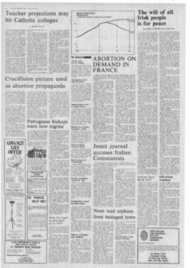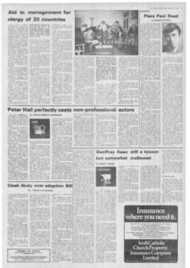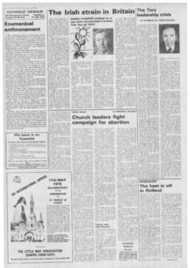Page 6, 24th January 1975
Page 6

Report an error
Noticed an error on this page?If you've noticed an error in this article please click here to report it.
Tags
Share
Related articles
Why Not Elevate Laity This Year?
The Chains That Bound A Free Man
God's Second Chosen People
Mocking Of Christ At Northampton Cathedral
Even The Ducks Have Irish Brogues In Their Quacks .
Pastor Iuventus
Dublin Jesuits remember the worker in chains
On a hot, drowsy Sunday in June, 1925, a shabbily dressed old man fell dead in a Dublin street. In the mortuary of Jervis Street Hospital the attendant uncovered the frail body of a one-time hopeless alcoholic — a body deeply embedded with penitential chains. It was the corpse of Matt Talbot.
The Irish worker in chains has been beaten by many, many lengths in the race for the first saint to be canonised in Ireland in 700 years. The winner is Oliver Plunkett, 17th century Archbishop of Armagh.
The body of Oliver lies in state in the Benedictine Abbey of Downside. His head is enshrined for veneration in Saint Peter's Church in Drogheda, County Louth, Ireland.
Both Matt and Oliver were under stances orders, for the canonisation stakes of 1975, and the almost silent Dublin workman has been beaten by the almost equally silent archbishop.
The spot al which Matt fell in Granby Lane, Dublin, near the Dominican Churchis, in my opinion, one of Ireland's holy places and well worth visiting in this Holy Year of 1975. So is his simple grave in the cemetery of Glasnevin a holy place, and the room in which he lived at 18 Upper Rutland Street.
Call into the Jesuit Fathers in St Francis Xavier's Church in Upper Gardiner Street, Dublin, and they will tell you all about their most illustrious parishioner. He attended daily Mass there at 5 o'clock every morning, after rising from his rough wooden bed of planks, with its wooden pillow, and its covers of half a blanket and an old sack.
Like many Dublin workmen of the twenties he lived mostly on hot cocoa and dry bread. His wages at his death were three pounds a week.
Matt left the Christian Brothers' school at 12 years of age. They have difficulty in remembering his presence at all, as he so frequently played truant. He went to work at 12 years of age.
Ile was then almost illiterate, but he graduated from reading the Jesuits' "Messenger of the Sacred Heart" to being .deeply read and conversant with the works of Aquinas, of Newman, of Augustine, of St John of the Cross, and with the devotion to the Blessed Virgin of de Montfort.
Occasionally he wrote down favourite quotations from his readings on scraps of paper in an elementary and child-like handwriting. On one of these scraps of paper we read: "The Kingdom of Heaven was promised not to the sensible and the educated but to such as have the spirit of little children."
Matt was a good listener. He seldom spoke, but when he did he really had something to say in the way of spiritual guidance for a friend, or advice on prayer. He was the antithesis of the many loquacious stoutdrinking Irishmen of today who all too often regard themselves as God's gift to the visiting English tourist.
It is well worth while visiting the Church of St Francis Xavier in Upper Gardiner Street to savour the silence which Matt Talbot found there. (Incidentally, at the age of 35, the Jesuit parish priest there qualifies for a new entry in the "Guinness Book of Records" as the youngest parish priest in Ireland.) Matt also frequented "Adam and Eve's," the Franciscan church on the Liffey Quays opposite the Four Courts, and made "visits" to the Blessed Sacrament in the Carmelite church in Clarendon Street, off Grafton Street, and told his beads in the Pro-Cathedral, and in the Church of Saint Laurence O'Toole.
Those were the days of "visits" and the rosary before we all became sophisticated after Vatican 11. These Dublin ehurches are some of Ireland's holy places and the congregations at morning or evening Mass present one with what Mathew Arnold once described as being made up of "All the pell-mell of all the men and women of Shakespeare's plays."
Matt had a thing about the wrong use of the Holy Name, and blasphemy. from which we could still learn a lesson in the Ireland of today.
He was a man of great silence in prayer, and in this respect he had much in common with Our Lady of Knock. She appeared at the little church of Knock in County Mayo in 1879. She appeared in the drizzling rain in a year of famine and utter misery to a hungry people. She said nothing. She was Our lady of Silence.
And Yet, one senses that she was moved to appear on the evening of August 21, 1879, to some 20 sane and simple people in a mute message of sympathy and understanding. There was no spoken message as she appeared on the gable wall of the parish church of Knock.
. There were three figures — herself, Saint Joseph and Saint John the Evangelist, and on the altar stood the Lamb of God with a cross. The total vision recalled the scene of the Apocalypse in the Gospel according to Saint John.
The late Archbishop of Tuam, like Matt, was a good listener and a man of very few words. As Archbishop of Tuam he was certainly more Tuam than Meum in his conversation, and I can vividly recall how he expressed his sincere belief in Our Lady of Silence of Knock.
Knock should be visited this Holy Year and a leaflet entitled "Pilgrimage to Knock," tells us that it is 138 miles by train from Dublin, 126 miles by bus from Dublin, and 134 miles from Dublin by road. So you pays your money and you takes your choice.
Blessed Oliver Plunkett, now to be the first formally recognised saint in Ireland for over 700 years, will be past the post in the canonisation stakes in October this year. We know that Pope Paul, when he was Mgr Montini, visited Drogheda In 1951 and beheld the head of Oliver in its shrine in Saint Peter's Church.
One wonders if the footsteps of Mgr Montini were directed to Granby Lane, and when the Dublin labourer will have his name added alongside that of Oliver Plunkett in the roll of Ireland's saints.
Oliver, like Matt, had a great devotion to the rosary, and on his way to his martyrdom at Tyburn he gave his rosary beads, his only possession, to his faithful servant James MacKenna who had been in his service for 11 years. These rosary beads are still preserved today by the descendants of James, who ministered to his master in prison.
At the hour of his death on the scaffold at Tyburn, the Archbishop of Armagh made a public declaration of his devotion to Our Lady which deeply moved all those present.
We are told; "He supplicated the Divine Majesty to be propitious to him, through the merits of Christ, through the intercession of the Blessed Virgin and of all holy Angels and Saints in Paradise, which form of prayer, so simple yet so pious, was remarked by the spectators who never remember to have heard from any other such an express mention of the .Blessed Virgin and the Saints."
That was on July 11, 1681, on the charge of fomenting revolt to re-establish "the religion of Rome."
He was born in the parish of Loughcrew, near Oldcastle, Co Meath, in 1625, ordained priest in Rome in 1654, and made Archbishop of Armagh in 1669.
These were years of an Irish Church in chaos and fear after the Cromwellian massacres and persecution. The charge against him was a pure fabrication for political ends to nail a Catholic bishop as a victim. He was killed simply because he was just that — a Catholic bishop.
As a Catholic bishop whose work was to endeavour to restore peace in his time through non-violence he is a splendid example for all of us today.
Because the Dundalk jury of 12 honest Irish Protestants were bound to acquit him, the politicians of Charles II had him tried in London — a trial which was as illegal as it was unjust.
But the elevation to the ranks of the saints of the 17th century Archbishop of Armagh who was always on such good terms with his Protestant fellow countrymen must surely have a lesson for 1975, as have the life of Matt Talbot, and the Apparition of Our Lady of Knock. Terence J. Sheehy is general manager in Britain of the Irish Tourist Board.
blog comments powered by Disqus











